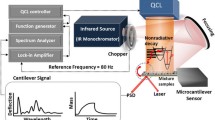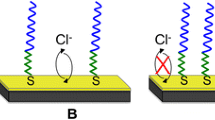Abstract
A microcantilever was modified with a self-assembled monolayer (SAM) of L-cysteine for the sensitively and selectively response to Cu(II) ions in aqueous solution. The microcantilever undergoes bending due to sorption of Cu(II) ions. The interaction of Cu(II) ions with the L-cysteine on the cantilever is diffusion controlled and does not follow a simple Langmuir adsorption model. A concentration of 10−10 M Cu(II) was detected in a fluid cell using this technology. Other cations, such as Ni2+, Zn2+, Pb2+, Cd2+, Ca2+, K+, and Na+, did not respond with a significant deflection, indicating that this L-cysteine-modified cantilever responded selectively and sensitively to Cu(II).







Similar content being viewed by others
References
Harris, E. D. (2001). Copper homeostasis: the role of cellular transporters. Nutrition Reviews, 59, 281–285.
Watts, D. L. (1998). The nutritional relationships of copper. Journal of Orthomolecular Medicine, 4, 99–109.
Brewer, G. J. (2012). Wilson’s disease. In D. L. Longo, A. S. Fauci, D. L. Kasper, S. L. Hauser, J. L. Jameson, & J. Loscalzo (Eds.), Harrison’s principles of internal medicine. 18th ed (pp. 3188–3190). New York: McGraw-Hill.
Odell, B. L. (1982). Biochemical basis of the clinical effects of copper deficiency (pp. 301–313). New York: Alan R Liss Inc.
Turnlund, J. R., Jacob, R. A., Keen, C. L., Strain, J. J., Kelley, D. S., Domek, J. M., et al. (2004). Long-term high copper intake: effects on indexes of copper status, antioxidant status, and immune function in young men. American Journal of Clinical Nutrition, 79, 1037–1044.
Thundat, T., Chen, G. Y., Warmack, R. J., Allison, D. P., & Wachter, E. A. (1996). Vapor detection using resonating microcantilevers. Analytical Chemistry, 67, 519–521.
Chen, G. Y., Thundat, T., Wachter, E. A., & Warmack, R. J. (1995). Adsorption-induced surface stress and its effects on resonance frequency of microcantilever. Journal of Applied Physics, 77, 3618–3622.
Lee, D., Kwon, D., Ko, W., Joo, J., Seo, H., Lee, S. S., & Jeon, S. (2012). A rapid and facile signal enhancement method for microcantilever-based immunoassays using the agglomeration of ferromagnetic nanoparticles. Chemical Communications, 48(57), 7182–7184.
Ziegler, C. (2004). Cantilever-based biosensors. Analytical and Bioanalytical Chemistry, 379, 946–959.
Johnson, B. N., & Mutharasan, R. (2012). Biosensing applications using dynamic-mode cantilever sensors: a review. Biosensors & Bioelectronics, 32, 1–18.
Lavrik, N. V., Sepaniak, M. J., & Datskos, P. G. (2004). Cantilever transducers as a platform for chemical and biological sensors. The Review of Scientific Instruments, 75, 2229–2253.
Ji, H. F., & Armon, B. (2010). Approaches to increasing surface stress for improving signal-to-noise ratio of microcantilever sensors. Analytical Chemistry, 82, 1634–1642.
Muller, P., & Kern, R. (1994). About the measurement of absolute isotropic surface stress of crystals. Surface Science, 301, 386–398.
Cleveland, J. P., Manne, S., Bocek, D., & Hansma, P. K. (1993). Nondestructive method for determining the spring constant of cantilevers for scanning force microscopy. Review of Scientific Instruments, 64, 403–405.
Butt, J. J. (1996). A sensitive method to measure changes in the surface stress of solids. Journal of Colloid Interface Science, 180, 251–260.
Gimzewski, J. K., Gerber, C., Meyer, E., & Schlittler, R. R. (1994). Observation of a chemical-reaction using a micromechanical sensor. Chemical Physics Letters, 217, 589–594.
Raiteri, R., & Butt, H.-J. (1995). Measuring electrochemically induced surface stress with an atomic force microscope. Journal of Physical Chemistry, 99, 15728–15732.
Rubinstein, I., Steinberg, S., Tor, Y., Shanzer, A., & Sagiv, J. (1988). Ionic recognition and selective response in self-assembling monolayer membrane on electrodes. Nature, 332, 426–429.
Bain, C. D., Troughton, E. B., Tao, Y.-T., Evall, J., Whitesides, G. M., & Nuzzo, R. G. (1989). Formation of monolayer films by the spontaneous assembly of organic thiols from solution onto gold. Journal of the American Chemical Society, 111, 321–335.
Thoden van Velzen, E. U., Engbersen, J. F. J., & Reinhoudt, D. N. J. (1994). Self-assembled monolayers of receptor adsorbates on gold: preparation and characterization. Journal of the American Chemical Society, 116, 3597–3598.
Aoki, H., Buhlmann, P., & Umezawa, Y. (1999). Self-assembly of a tricarboxylate receptor through thioamide groups and its use for electrochemical detection of protonated amines. Journal of Electroanalytical Chemistry, 473, 105–112.
Wink, T., van Zuilen, S. J., Bult, A., & van Bennekom, W. P. (1997). Self-assembled monolayers for biosensors. Analyst, 122, 43R–50R.
Gooding, J., & Brynn, H. D. (1999). The application of alkanethiol self-assembled monolayers to enzyme electrodes. Trends in Analytical Chemistry, 18, 525–533.
Flink, S., Van Veggel, F. C. J. M., & Reinhoudt, D. N. (2000). Sensor functionalities in self-assembled monolayers. Advanced Materials, 12, 1315–1328.
Hansen, K., Ji, H. F., Guanghua, W., Datar, R., Cote, R., Majumdar, A., & Thundat, T. (2001). Cantilever-based optical deflection assay for discrimination of DNA single-nucleotide mismatches. Analytical Chemistry, 73, 1567–1571.
Ji, H. F., & Thundat, T. (2002). In situ detection of calcium ions with chemically modified microcantilevers. Biosensors & Bioelectronics, 17, 337–343.
Wadsak, M., Schreinger, M., Aastrup, T., & Leygraf, C. (2000). Combined in-situ investigations of atmospheric corrosion of copper with SFM and IRAS coupled with QCM. Surface Science, 454, 246–250.
Telegdi, J., Shaban, A., & Kálmán, E. (2000). EQCM study of copper and iron corrosion inhibition in presence of organic inhibitors and biocides. Electrochimica Acta, 45(22), 3639–3647.
Liu, A. C., Chen, D. C., Lin, C. C., Chou, H. H., & Chen, C. H. (1999). Application of cysteine monolayers for electrochemical determination of sub-ppb copper(II). Analytical Chemistry, 71, 1549–1552.
Arrigan, D. W. M., & Le Bihan, L. (1999). A study of L-cysteine adsorption on gold via electrochemical desorption and copper(II) ion complexation. Analyst, 124, 1645–1649.
Yang, W., Gooding, J. J., & Hibbert, D. B. (2001). Characterisation of gold electrodes modified with self-assembled monolayers of l-cysteine for the adsorptive stripping analysis of copper. Journal Electroanalytical Chemistry, 516, 10–16.
Bai, Y., Ruan, X., Mo, J., & Xie, Y. (1998). Potentiometric stripping analysis of copper using cysteine modified mercury film electrode. Analytica Chimica Acta, 373, 39–46.
Taillades, G., Valls, O., Bratov, A., Dominguez, C., Pradel, A., & Ribes, M. (1999). ISE and ISFET microsensors based on a sensitive chalcogenide glass for copper ion detection in solution. Sensors and Actuators B-Chemical, 59, 123–127.
Yang, W., Jaramillo, D., Gooding, J. J., Hibbert, D. B., Zhang, R., Willett, G. D., & Fisher, K. J. (2001). Sub-ppt detection limits for copper ions with Gly-Gly-His modified electrodes. Chemical Communication, 1982–1983.
Yang, Y., Ji, H.-F., & Thundat, T. (2003). Nerve agents detection using a Cu2+/L-cysteine bilayer-coated microcantilever. Journal of the American Chemical Society, 125, 1124–1125.
Berger, R., Delamarche, E., Lang, H. P., Gerber, C., Gimzewski, J. K., Meyer, E., & Guntherodt, H.-J. (1998). Surface stress in the self-assembly of alkanethiols on gold probed by a force microscopy technique. Applied Physics A: Materials Science & Processing, 66, S55–S59.
Kallay N ed. (2000). Interfacial dynamics. Marcel Dekker Inc.
Almgren, M., Linse, P., Van der Auweraer, M., De Schryver, F. C., Gelade, E., & Croonen, Y. (1984). Fluorescence quenching by counter ions in ionic micelle solution. The effect of ion migration. Journal of Physical Chemistry, 88, 289–295.
Acknowledgements
H. F. Ji, X. Xu, and N. Zhang thank NSF Sensor and Sensor Network ECS-0428263 for financially supporting this research. T. Thundat and G. M. Brown were funded by the Environmental Remediation Sciences Division, Office of Biological and Environmental Research, Environmental Management Science Program, US Department of Energy, under contract No. DE-AC05-00OR22725 with Oak Ridge National Laboratory managed and operated by UT-Battelle, LLC for the USDOE.
Author information
Authors and Affiliations
Corresponding author
Rights and permissions
About this article
Cite this article
Xu, X., Zhang, N., Brown, G.M. et al. Ultrasensitive Detection of Cu2+ Using a Microcantilever Sensor Modified with L-Cysteine Self-Assembled Monolayer. Appl Biochem Biotechnol 183, 555–565 (2017). https://doi.org/10.1007/s12010-017-2511-7
Received:
Accepted:
Published:
Issue Date:
DOI: https://doi.org/10.1007/s12010-017-2511-7




